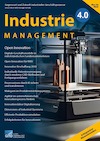Search


Bibtex
Cite as text
@Article{Brylowski+Schöpper+Krull,
Year= "2019",
Number= "5",
Volume= "35",
Pages= "50-54",
Journal = "Industrie 4.0 Management",
Title= "Produktmodularisierung entlang der Supply Chain: Wie die Umsetzung gelingt",
Author= "Martin {Brylowski}, Henning {Schöpper} und Marwin {Krull}",
Doi= "https://doi.org/10.30844/I40M_19-5_S50-54",
Abstract= "Der fortschreitende technologische Wandel, die Globalisierung der Märkte sowie zunehmend steigende Kundenanforderungen haben zu einem deutlichen Anstieg der Komplexität in produzierenden Unternehmen und deren Supply Chains geführt. Unternehmen und gesamte Wertschöpfungsketten begegnen dieser Entwicklung u. a. mit Produktmodularisierungsstrategien. In diesem Kontext findet jedoch die Untersuchung der Einflüsse von Produktmodularisierung auf die Supply Chain nur wenig Beachtung. Dies kann in der Folge zu ungenutzten Potenzialen und zusätzlichen Risiken, wie dem Verlust der Kernkompetenzen, führen. Vor diesem Hintergrund beschäftigt sich der vorliegende Beitrag mit Prozessen und Erfolgsfaktoren, die sich durch eine gemeinsame Betrachtung von Produktmodularisierung entlang der Supply Chain ergeben. Auf Basis einer systematischen Analyse wissenschaftlicher Literatur und leitfadengestützten Experteninterviews wurden ein Vorgehensmodell mit unterschiedlichen Phasen und Schritten erarbeitet sowie die notwendigen Erfolgsfaktoren identifiziert. ",
Keywords= "Komplexität, Modularisierung, Supply Chain, Erfolgsfaktoren, Vorgehensmodell",
}
Martin {Brylowski}, Henning {Schöpper} und Marwin {Krull}(2019): Produktmodularisierung entlang der Supply Chain: Wie die Umsetzung gelingt. 355(2019), S. 50-54. Online: https://doi.org/10.30844/I40M_19-5_S50-54 (Abgerufen 21.10.24)
Open Access
Abstract
Abstract
Der fortschreitende technologische Wandel, die Globalisierung der Märkte sowie zunehmend steigende Kundenanforderungen haben zu einem deutlichen Anstieg der Komplexität in produzierenden Unternehmen und deren Supply Chains geführt. Unternehmen und gesamte Wertschöpfungsketten begegnen dieser Entwicklung u. a. mit Produktmodularisierungsstrategien. In diesem Kontext findet jedoch die Untersuchung der Einflüsse von Produktmodularisierung auf die Supply Chain nur wenig Beachtung. Dies kann in der Folge zu ungenutzten Potenzialen und zusätzlichen Risiken, wie dem Verlust der Kernkompetenzen, führen. Vor diesem Hintergrund beschäftigt sich der vorliegende Beitrag mit Prozessen und Erfolgsfaktoren, die sich durch eine gemeinsame Betrachtung von Produktmodularisierung entlang der Supply Chain ergeben. Auf Basis einer systematischen Analyse wissenschaftlicher Literatur und leitfadengestützten Experteninterviews wurden ein Vorgehensmodell mit unterschiedlichen Phasen und Schritten erarbeitet sowie die notwendigen Erfolgsfaktoren identifiziert.
Keywords
Schlüsselwörter
Komplexität, Modularisierung, Supply Chain, Erfolgsfaktoren, Vorgehensmodell
References
Referenzen
[1] Krause, D.; Gebhardt, N.: Methodische Entwicklung modularer Produktfamilien – Hohe Produktvielfalt beherrschbar entwickeln (2018).
[2] Daniildis, C.: Planungsleitfaden für die systematische Analyse- und Verbesse-rung von Produktarchitekturen 2017.
[3] Verband Deutscher Maschinen- und Anlagenbau e.V.: Zukunftsperspektive deutscher Maschinenbau (2014).
[4] Werner, H.: Supply Chain Management – Grundlagen, Strategien, Instrumente und Controlling, 6. Auflage. Wiesbaden 2017.
[5] Skirde, H.; Kersten, W.; Schröder, M.: Measuring the cost effects of modular product architectures. In: International Journal of Innovation and Technology Management (2016).
[6] Wildemann, H.: Supply Chain Management – Leitfaden für ein unternehmensübergreifendes Wertschöpfungsmanagement (2016).
[7] Serdarasan, S.: A review of supply chain complexity drivers. In: Computers & In-dustrial Engineering (2013).
[8] Ulrich, K.: The role of product architecture in the manufacturing firm. In: Research Policy (1995).
[9] Smith, G. F.; Browne, G. J.: Conceptual Foundations of Design Solving Problems. In: IEEE Transactions on Systems, Man and Cybernetics (1993).
[10] Gan, T.-S.; Grunow, M.: Concurrent Product – Supply Chain Design: A Concep-tual Framework & Literature Review. In: Procedia CIRP (2013).
[11] Tranfield, D.; Denyer, D.; Smart, P.: Towards a Methodology for Developing Evidence-Informed Management Knowledge by Means of Systematic Review. In: British Journal of Management 14 (2003) 3, S. 207–22.
[12] Denyer, D.; Tranfield, D.: Producing a Systematic Review. In: Buchanan, D. A.; Bryman, A. (Hrsg.): The Sage Handbook of Organizationen Research Methods. London 2009.
[13] Mayring, P.; Fenzl, T.: Qualitative Inhaltsanalyse. In: Baur, N.; Blasius, J. (Hrsg.): Handbuch Methoden der empirischen Sozialforschung. Wiesbaden 2019.
[14] Skirde, H.: Kostenorientierte Bewertung modularer Produktarchitekturen (2015).
[15] Aoki, K.; Staeblein, T.: Monozukuri capability and dynamic product variety: An analysis of the design-manufacturing interface at Japanese and German automakers. In: Technovation 70-71 (2018), S. 33–45.
[16] Brun, A.; Zorzini, M.: Evaluation of product customization strategies through modularization and postponement. In: International Journal of Production Economics 120 (2009) 1, S. 205–20.
[17] Cabigiosu, A.; Camuffo, A.: Measuring Modularity: Engineering and Management Effects of Different Approaches (2017).
[18] Caniato, F.; Größler, A.: The moderating effect of product complexity on new product development and supply chain management integration. In: Production Planning & Control 26 (2015) 16, S. 1306–17.
[19] Lau, A. K.W.; Yam, R. C.M.; Tang, E. P.Y.; Sun, H. Y.: Factors influencing the relationship between product modularity and supply chain integration. In: International Journal of Operations & Production Management 30 (2010) 9, S. 951–77.
[20] Suh, C. J.; Lee, I. T.: An Empirical Study on the Manufacturing Firm’s Strategic Choice for Sustainability in SMEs. In: Sustainability 10 (2018) 3, S. 572.
[21] Cheng, L.-C.: Assessing performance of utilizing organizational modularity to manage supply chains: Evidence in the US manufacturing sector. In: International Journal of Production Economics 131 (2011) 2, S. 736–46.
[22] Das, K.; Chowdhury, A. H.: Designing a reverse logistics network for optimal collection, recovery and quality-based product-mix planning. In: International Journal of Production Economics 135 (2012) 1, S. 209–21.
[23] Droge, C.; Vickery, S. K.; Jacobs, M. A.: Does supply chain integration mediate the relationships between product/process strategy and service performance? An empirical study. In: International Journal of Production Economics 137 (2012) 2, S. 250–62.
[24] Gomes, P. J.; Dahab, S.: Bundling resources across supply chain dyads. In: International Journal of Operations & Production Management 30 (2010) 1, S. 57–74.
[25] Haug, A.: Improving the design phase through interorganisational product knowledge models (2015).
[26] Huang, T.-T. A.; Stewart, R. A.; Le Chen: Identifying key enablers to improve business performance in Taiwanese electronic manufacturing companies. In: International Journal of Operations & Production Management 30 (2010) 2, S. 155–80.
[27] Lee, H. L.; Schmidt, G.: Using Value Chains to Enhance Innovation. In: Production and Operations Management 26 (2017) 4, S. 617–32.
[28] Caridi, M.; Pero, M.; Sianesi, A.: Linking product modularity and innovativeness to supply chain management in the Italian furniture industry.
[29] Sorkun, M. F.; Furlan, A.: Product and Organizational Modularity: A Contingent View of the Mirroring Hypothesis. In: European Management Review 14 (2017) 2, S. 205–24.
[30] Squire, B.; Cousins, P. D.; Lawson, B.; Brown, S.: The effect of supplier manufacturing capabilities on buyer responsiveness. In: International Journal of Operations & Production Management 29 (2009) 8, S. 766–88.
[31] Aitken, J.; Harrison, A.: Supply governance structures for reverse logistics systems (2013).
[32] Ergu, D.; Kou, G.; Shang, J.: A Modular-Based Supplier Evaluation Framework:. A Comprehensive Data Analysis of ANP Structure (2014).
[33] Romano, P.; Formentini, M.: Designing and implementing open book accounting in buyer–supplier dyads A framework for supplier selection and motivation (2012).
[34] Chavez, R.; Yu, W.; Gimenez, C.; Fynes, B.; Wiengarten, F.: Customer integration and operational performance: The mediating role of information quality (2015).

 English
English